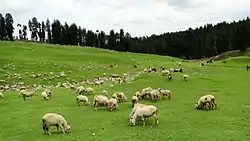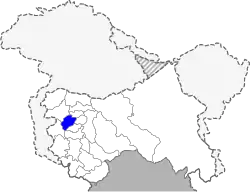Budgam district
Budgam district is a district in the Indian administered union territory of Jammu and Kashmir. Created in 1979 with its headquarters at Budgam, it is the district with the largest population of Shias in the Kashmir valley.[1]
Budgam, Jammu and Kashmir | |
|---|---|
 Doodhpathri pastures in Budgam district | |
 Location of Budgam district in Jammu and Kashmir | |
| Coordinates: 34°1′12″N 74°46′48″E | |
| Country | |
| Union Territory | Jammu and Kashmir |
| Established | 1979 |
| Founded by | Aga Syed Yousuf |
| Headquarters | Budgam |
| Government | |
| • Type | Democracy |
| Area | |
| • Total | 1,370 km2 (530 sq mi) |
| Population (2011) | |
| • Total | 753,745 |
| • Density | 537/km2 (1,390/sq mi) |
| Languages | |
| • Official | Urdu Kashmiri |
| Time zone | UTC+5:30 (IST) |
| Vehicle registration | JK04 |
| Sex ratio | 1.13250283 ♂/♀ |
| Literacy | 57.98% |
| Villages | Ichgam, Khansahib, Parnewa, Beerwah, Chadoora, Wahabpora |
| Website | budgam |
Administration
Budgam district is the closest district to capital Srinagar (11 km). Budgam district came into existence in 1979, prior to which it was part of Srinagar district. In former times, Budgam was a part of Baramulla district, when Srinagar itself was a constituent of the Anantnag district. It was then known as tehsil Sri Pratap. Historical records suggests that Budgam was also referred to as Pargana Deesu. According to the well-known chronicler Khawaja Azam Demari, the area was also known as Deedmarbag. Budgam district borders the districts of Baramullah and Srinagar in the north, Pulwama in the south and Poonch in the south west. It consists of eight blocks: Beerwah, Magam, Budgam, B.K.Pora, Khan Sahib, Khag, Narbal and Chadoora.[2] Each block consists of a number of panchayats. The district is subdivided into the nine tehsils of Charari Sharief Tehsil, Magam tehsil, Beerwah Tehsil, Budgam Tehsil, Chadoora Tehsil, Khansahib Tehsil, Khag Tehsil, BK Pora Tehsil and Narbal Tehsil .[3][4]
Tehsils of Budgam
Other details
| Number of Sub-division | 03 |
| Number of Municipalties | 06 |
| Number of Tehsils | 09 |
| Number of Blocks | 17 |
| Number of Gram Panchayats | 281 |
| Number of villages | 510 |
Demography
Budgam district: mother-tongue of population, according to the 2011 Census.[6]
According to the 2011 census Budgam district has a population of 735,753[7] roughly equal to the nation of Guyana[8] or the US state of Alaska,[9] making it 494th in India (out of a total of 640). The district has a population density of 554 inhabitants per square kilometre (1,430/sq mi).[7] Its population growth rate over the decade 2001-2011 was 24.14%.[7] Badgam has a sex ratio of 883 females for every 1000 males,[7] and a literacy rate of 56.08% (males 66.30%, females 44.85$),[7] an increase from 42.20% (males 53.13%, females 30.29%) in 2001.[7] Literacy is higher in urban areas (average 68.87%, male 79.46%, female 55.38%) than in rural areas (average 54.01%, male 64.00%, female 43.29%).[7]
| Budgam district: religion, gender ratio, and % urban of population, according to the 2011 Census.[5] | |||||||||
|---|---|---|---|---|---|---|---|---|---|
| Hindu | Muslim | Christian | Sikh | Buddhist | Jain | Other | Not stated | Total | |
| Total | 10,110 | 736,054 | 1,489 | 5,559 | 47 | 6 | 2 | 478 | 753,745 |
| 1.34% | 97.65% | 0.20% | 0.74% | 0.01% | 0.00% | 0.00% | 0.06% | 100.00% | |
| Male | 9,119 | 384,281 | 965 | 3,321 | 36 | 4 | 1 | 314 | 398,041 |
| Female | 991 | 351,773 | 524 | 2,238 | 11 | 2 | 1 | 164 | 355,704 |
| Gender ratio (% female) | 9.8% | 47.8% | 35.2% | 40.3% | 23.4% | 33.3% | 50.0% | 34.3% | 47.2% |
| Sex ratio (no. of females per 1,000 males) |
109 | 915 | 543 | 674 | – | – | – | – | 894 |
| Urban | 7,502 | 89,111 | 561 | 635 | 26 | 3 | 0 | 74 | 97,912 |
| Rural | 2,608 | 646,943 | 928 | 4,924 | 21 | 3 | 2 | 404 | 655,833 |
| % Urban | 74.2% | 12.1% | 37.7% | 11.4% | 55.3% | 50.0% | 0.0% | 15.5% | 13.0% |
At the time of the 2011 Census of India, 94.78% of the population in the district spoke Kashmiri as their first language.[6]
Budgam district
| |||
|---|---|---|---|
| Mother tongue code | Mother tongue | People | Percentage |
| 001002 | Assamese | 333 | 0.04% |
| 002007 | Bengali | 635 | 0.08% |
| 004001 | Dogri | 592 | 0.08% |
| 005018 | Gujarati | 119 | 0.02% |
| 006102 | Bhojpuri | 152 | 0.02% |
| 006195 | Garhwali | 66 | 0.01% |
| 006207 | Gojri/Gujjari/Gujar | 22,706 | 3.01% |
| 006240 | Hindi | 5,175 | 0.69% |
| 006400 | Marwari | 55 | 0.01% |
| 006439 | Pahari | 1,732 | 0.23% |
| 007016 | Kannada | 154 | 0.02% |
| 008005 | Kashmiri | 714,418 | 94.78% |
| 011016 | Malayalam | 325 | 0.04% |
| 012003 | Meitei (Manipuri) | 145 | 0.02% |
| 013071 | Marathi | 750 | 0.10% |
| 015043 | Odia | 425 | 0.06% |
| 016038 | Punjabi | 3,759 | 0.50% |
| 020027 | Tamil | 486 | 0.06% |
| 021046 | Telugu | 421 | 0.06% |
| 022015 | Urdu | 345 | 0.05% |
| 040001 | English | 218 | 0.03% |
| 082005 | Lushai/Mizo | 90 | 0.01% |
| 109005 | Shina | 53 | 0.01% |
| – | Others | 591 | 0.08% |
| Total | 753,745 | 100.00% | |
Education
There are 590 schools in Budgam, both private and public, 33 of which are Higher Secondary Schools. The Government Degree College, Budgam is located near the Paller village. It is the only degree college in district Budgam. Budgam is of one of backward districts in kashmir till date because some political issues. Budgam is district is also known to its great Muslim preachers as:Baba-Hanif-Ud-Din, locally the graveyard is known as "Baba sabin Ziyarath" which is situated at the most beautiful mountain which ends up in Rathsun, a small cute village. The people of Rathsun are very kind, as from the old times. Magam is one of the main town in budgam right now, because it is approximately at centre of the district budgam. Ompora, Charar Sharif, Kralpora, Gotapora and Soibugh are highly populated localities of Budgam district. Magam, Ichgam, Iskandarpora, Wahabpora villages of Budgam district are the biggest villages with Shia population.
Attractions
.jpg.webp)
Budgam contains the only airport in Kashmir valley at Ichgam. The district's main tourist attractions are Doodhpathri, Yusmarg, Tosamaidan, Nilnag, Khag and Pehjan. District Budgam offers many stunning locales and has tremendous tourism potential that has largely remained untapped so far. The attractive places that can be visited are Doodhpathri, Yousmarg, Tosamaidan, Nilnag and Khag. Kani Shawl adomed the caesar's court and was looked upon by Mughals and later by Nawabs as mark of nobility. In 1776, Napoleon Bonaparte presented a Kani shawl to his wife Josephine and with that took off a new fashion trend in Europe. The revered shrine of Sheikh Noor-ud-din Wali can also be found in the Charari Sharief Tehsil of Budgam district. Asia's oldest/largest Chinar resides at Chattergam Budgam. Aga Sahib Shrine is also situated in this district.
The Budgam railway station is located in Ompora town nearly 2.5 km from district headquarters and 9 km from city centre Lalchowk. It is the biggest railway station in Kashmir division. This railway station has administrative head controlling the rail service in Kashmir valley. Outside railway station Ompora (Budgam) there is a big hospital, named Ibn-Sina Hospital, which is Budgam district's first private hospital.
Notable people
References
- "Are Kashmiri Shias The Next Pandits?". 14 November 2013. Archived from the original on 21 June 2015. Retrieved 21 May 2014.
- Statement showing the number of blocks in respect of 22 Districts of Jammu and Kashmir State including newly Created Districts Archived 10 September 2008 at the Wayback Machine dated 2008-03-13, accessed 2008-08-30
- "ERO's and AERO's". Chief Electoral Officer, Jammu and Kashmir. Archived from the original on 22 October 2008. Retrieved 28 August 2008.
- https://budgam.nic.in/tehsil/
- C-1 Population By Religious Community – Jammu & Kashmir (Report). Office of the Registrar General & Census Commissioner, India. Retrieved 28 July 2020.
- C-16 Population By Mother Tongue – Jammu & Kashmir (Report). Office of the Registrar General & Census Commissioner, India. Retrieved 18 July 2020.
- "District Census 2011: Badgam District". Census2011.co.in. 2011. Retrieved 15 January 2021.
- US Directorate of Intelligence. "Country Comparison:Population". Retrieved 1 October 2011.
Guyana 744,768
- "2010 Resident Population Data". U. S. Census Bureau. Archived from the original on 1 January 2011. Retrieved 30 September 2011.
Alaska 710,231